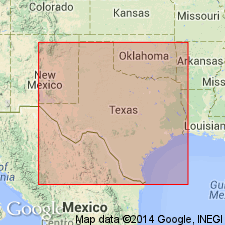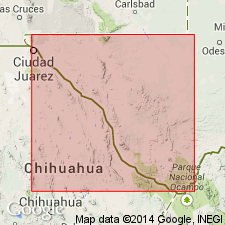
- Usage in publication:
-
- Bee Mountain Basalt Member
- Modifications:
-
- Areal extent
- Dominant lithology:
-
- Basalt
- AAPG geologic province:
-
- Permian basin
Summary:
Pg. 23, 26, pl. 2, road logs. Bee Mountain Basalt Member of Chisos Formation of Big Bend Park Group. Overlies Ash Spring Basalt Member (new) and underlies Mule Ear Spring Tuff Member (new) in Chisos Mountains. Overlies Alamo Creek Basalt Member in Lajitas Mesa. Thickness about 100 feet at Casa Grande Peak. Age is late Eocene.
Source: US geologic names lexicon (USGS Bull. 1350, p. 55-56).

- Usage in publication:
-
- Bee Mountain Basalt Member
- Modifications:
-
- Principal reference
- Dominant lithology:
-
- Basalt
- AAPG geologic province:
-
- Permian basin
Summary:
Pg. 118-119, pls. Bee Mountain Basalt Member of Chisos Formation. Formal proposal of name. Most extensive basalt member of the Chisos. Mostly fine to medium-grained, consisting of several flows that are conspicuously scoriaceous or vuggy along contacts. Thickness about 25 to 80 feet in the higher Chisos Mountains, but thickness increases southwestward to 527 feet at Cerro Castellano. Lies on erosion surface in Chisos Formation. Occurs above Ash Spring Basalt Member and below Mule Ear Spring Tuff Member (both of Chisos). Present at many places west and southwest of Chisos Mountains, and is traceable from lowlands eastward into Chisos Mountains. Extends southward from Big Bend National Park into Mexico, northwestward into southeastern foothills of Bofecillos Mountains, and is present in Black Gap east of the Sierra del Carmen. Age is late Eocene.
Type locality: Bee Mountain, in southwestern part of Big Bend National Park, Brewster Co., southwestern TX.
Source: US geologic names lexicon (USGS Bull. 1350, p. 55-56).

- Usage in publication:
-
- Bee Mountain Basalt [Member]
- Modifications:
-
- Geochronologic dating
- AAPG geologic province:
-
- Permian basin
Summary:
Pg. 24. Bee Mountain Basalt [Member] of Chisos Formation. Basalt flow samples from Lajitas quadrangle, Presidio County, southwestern Texas, yielded K-Ar ages of 34.5 +/-1.8 Ma and 23.1 +/-1.2 Ma (whole-rock). The 34.5 Ma age is reasonable; 23.1 Ma is impossible. Data from R.A. Maxwell and others, 1967 (Univ. Texas-Austin Pub. 6711, 320 p.); ages recalculated using decay constants of Steiger and Jager, 1977 (Earth Planet. Sci. Letters, v. 36, p. 359-362). [Age considered Oligocene. Eocene-Oligocene boundary 36.6 (38-34) Ma (from Geologic Names Committee, USGS, 1983 ed. geol. time scale, with additions from N.J. Snelling, 1985, The Geol. Soc. Mem., no. 10).]
Source: Publication.
For more information, please contact Nancy Stamm, Geologic Names Committee Secretary.
Asterisk (*) indicates published by U.S. Geological Survey authors.
"No current usage" (†) implies that a name has been abandoned or has fallen into disuse. Former usage and, if known, replacement name given in parentheses ( ).
Slash (/) indicates name conflicts with nomenclatural guidelines (CSN, 1933; ACSN, 1961, 1970; NACSN, 1983, 2005, 2021). May be explained within brackets ([ ]).

